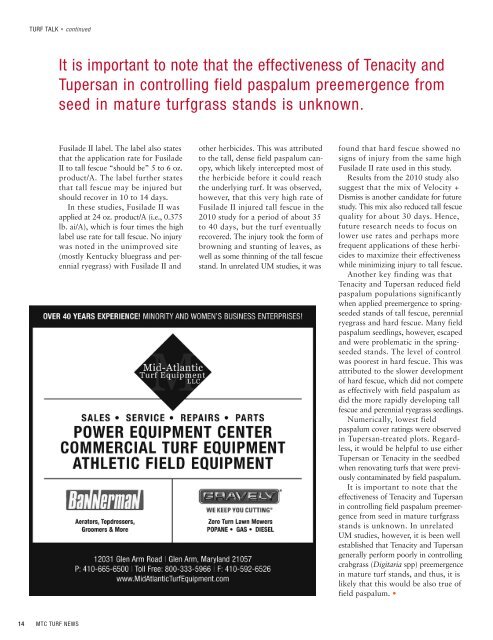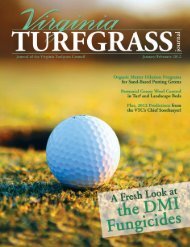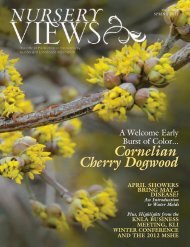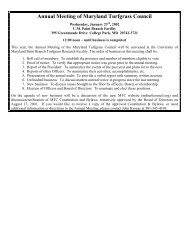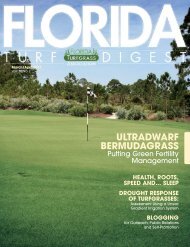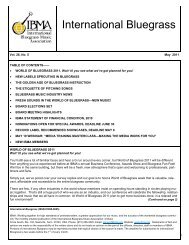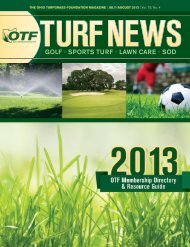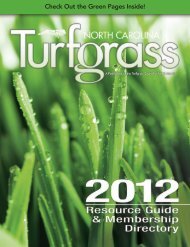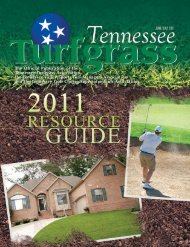the Fate of Field Paspalum Control - The Paginator
the Fate of Field Paspalum Control - The Paginator
the Fate of Field Paspalum Control - The Paginator
You also want an ePaper? Increase the reach of your titles
YUMPU automatically turns print PDFs into web optimized ePapers that Google loves.
TURF TALK • continued<br />
It is important to note that <strong>the</strong> effectiveness <strong>of</strong> Tenacity and<br />
Tupersan in controlling field paspalum preemergence from<br />
seed in mature turfgrass stands is unknown.<br />
Fusilade II label. <strong>The</strong> label also states<br />
that <strong>the</strong> application rate for Fusilade<br />
II to tall fescue “should be” 5 to 6 oz.<br />
product/A. <strong>The</strong> label fur<strong>the</strong>r states<br />
that tall fescue may be injured but<br />
should recover in 10 to 14 days.<br />
In <strong>the</strong>se studies, Fusilade II was<br />
applied at 24 oz. product/A (i.e., 0.375<br />
lb. ai/A), which is four times <strong>the</strong> high<br />
label use rate for tall fescue. No injury<br />
was noted in <strong>the</strong> unimproved site<br />
(mostly Kentucky bluegrass and perennial<br />
ryegrass) with Fusilade II and<br />
o<strong>the</strong>r herbicides. This was attributed<br />
to <strong>the</strong> tall, dense field paspalum canopy,<br />
which likely intercepted most <strong>of</strong><br />
<strong>the</strong> herbicide before it could reach<br />
<strong>the</strong> underlying turf. It was observed,<br />
however, that this very high rate <strong>of</strong><br />
Fusilade II injured tall fescue in <strong>the</strong><br />
2010 study for a period <strong>of</strong> about 35<br />
to 40 days, but <strong>the</strong> turf eventually<br />
recovered. <strong>The</strong> injury took <strong>the</strong> form <strong>of</strong><br />
browning and stunting <strong>of</strong> leaves, as<br />
well as some thinning <strong>of</strong> <strong>the</strong> tall fescue<br />
stand. In unrelated UM studies, it was<br />
found that hard fescue showed no<br />
signs <strong>of</strong> injury from <strong>the</strong> same high<br />
Fusilade II rate used in this study.<br />
Results from <strong>the</strong> 2010 study also<br />
suggest that <strong>the</strong> mix <strong>of</strong> Velocity +<br />
Dismiss is ano<strong>the</strong>r candidate for future<br />
study. This mix also reduced tall fescue<br />
quality for about 30 days. Hence,<br />
future research needs to focus on<br />
lower use rates and perhaps more<br />
frequent applications <strong>of</strong> <strong>the</strong>se herbicides<br />
to maximize <strong>the</strong>ir effectiveness<br />
while minimizing injury to tall fescue.<br />
Ano<strong>the</strong>r key finding was that<br />
Tenacity and Tupersan reduced field<br />
paspalum populations significantly<br />
when applied preemergence to springseeded<br />
stands <strong>of</strong> tall fescue, perennial<br />
ryegrass and hard fescue. Many field<br />
paspalum seedlings, however, escaped<br />
and were problematic in <strong>the</strong> springseeded<br />
stands. <strong>The</strong> level <strong>of</strong> control<br />
was poorest in hard fescue. This was<br />
attributed to <strong>the</strong> slower development<br />
<strong>of</strong> hard fescue, which did not compete<br />
as effectively with field paspalum as<br />
did <strong>the</strong> more rapidly developing tall<br />
fescue and perennial ryegrass seedlings.<br />
Numerically, lowest field<br />
paspalum cover ratings were observed<br />
in Tupersan-treated plots. Regardless,<br />
it would be helpful to use ei<strong>the</strong>r<br />
Tupersan or Tenacity in <strong>the</strong> seedbed<br />
when renovating turfs that were previously<br />
contaminated by field paspalum.<br />
It is important to note that <strong>the</strong><br />
effectiveness <strong>of</strong> Tenacity and Tupersan<br />
in controlling field paspalum preemergence<br />
from seed in mature turfgrass<br />
stands is unknown. In unrelated<br />
UM studies, however, it is been well<br />
established that Tenacity and Tupersan<br />
generally perform poorly in controlling<br />
crabgrass (Digitaria spp) preemergence<br />
in mature turf stands, and thus, it is<br />
likely that this would be also true <strong>of</strong><br />
field paspalum. •<br />
14 MTC TURF NEWS


